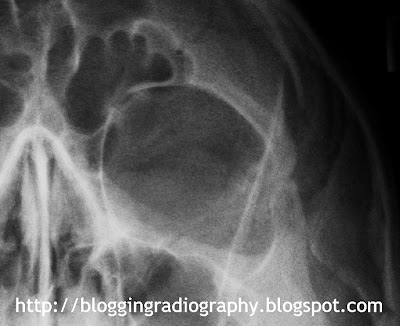It is still very common to receive orders for patients who need MRI exams, but require radiographic clearance to ensure there are no metal fragments in the eyes. Routines vary from place to place, but reasons for performing this exam include metal/machine shop workers, history of foreign body removal from the eyes, or shrapnel injuries. Our hospital only requires a water's view to include the orbits. Here is a good example of what to look for, as well as what to do if the reading may be positive:
I didn't notice anything in the orbits at first, but when viewed on the high resolution screen of a Radiologist, you may see a small speck at the superiolateral aspect of the left orbit:
I thought this would be too far above the orbital rim to be considered a metal fragment in the eyeball, however due diligence should prevail because it may be metal regardless of where it's located. When this happens, here's what you do:
- Use a different cassette. Dust and dirt may collect on the image plate and prevent light spread during processing for the affected area.
- Clean your cassettes. Most manufacturers recommend monthly cleaning of image plates, however, I may start cleaning them additionally before I perform any orbits for MRI clearance based on the repeat image:
As you can see on the magnified image, the white spot is no longer there, which means it was most likely dust... and the patient gets the MRI!

























